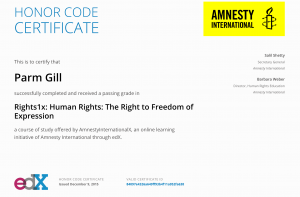Bryan Alexander (2014) envisions the early 21st century as a “Renaissance” in education, and by the year 2024, classes are based around the students creating multimedia projects in various forms through developing rich content in gamified classroom structures. According to this vision, Alexander states that “games and social media are delivery mechanisms for curricular content. Much of the curriculum involves creation: storytelling, game making, collaborative media work” (2014). I feel that this vision of the future of technology integration within education is what interests and excites me the most. Within this particular area of emerging technologies, there exists a potential to engage and motivate our students in ways that create powerful connections between their learning and their own personal interests and values.
Game-based learning functions to leverage student engagement, achievement and collaboration opportunities in order to promote the development of communication and problem solving skills, as well as creativity and self-confidence. Gaming has played a significant role in the lives of our students outside of the school context for years, and likely many of us were once engaged (or perhaps still are engaged) through participating in gaming opportunities, whether they be system based, online or otherwise. With this prevalence of gaming in the lives of our students, beginning at seemingly early ages, how do we as educators build this interest into our own design thinking to create learning opportunities that enhance skill development and digital literacies?
To help facilitate the integration of game-based learning into classroom and educational settings, I hope that we can approach the notion of technologies for learners by creating opportunities for students to plan and design their own games through various programming and design options. Through student involvement in the design process of game-based learning, our students can utilize technologies that are designed to be flexible, customizable, and adaptive to learner needs, while supporting students in planning for and achieving their own personal goals.
Despite the benefits of enhanced student engagement and motivation, and the development of skills in creativity, problem solving and collaboration, technologies for learners (including programming) have been slow to gain entry into formal educational settings, as their integration necessitates major changes in school cultures. In some cases, it seems that technologies for learners have not been widely accepted in school instructional programs because they challenge the standards-based perspective on instructional change in schools. As educators, how do we effectively manage and best align the implementation and integration of technologies for learners with institutionally based requirements, while engaging our students and impacting their development through approaches to game-based design and learning? Finding a balance between these considerations seems to hold the key for moving educational technology forward into the future.
By reflecting on the roles that technology plays in the current educational climate, we also need to reflect on past approaches to technology, and to consider how we’ve ultimately arrived where we are. While reading about Alexander’s envisioning of the future of education, I was continually reminded of the work of Seymour Papert, and the ways in which Papert’s ideas and perspectives on educational technology can help move us toward an exciting and engaging future for our students.
Seymour Papert’s influence extends throughout current pedagogical approaches to the integration of educational technology, constructionism, and the teaching of science and mathematics, to name but a few areas of significance. Papert and Solomon’s Twenty Things to Do With a Computer (1971), raises key questions and issues around educational technology that are still current and overwhelmingly relevant, more than 40 years after the report had been written. Papert and Solomon question the reasons as to why schools seemed to be “confined” in their approach to educational technology to uses that limit students to problem solving uses rather than opportunities to produce some form of action. The answer to this, according to Papert and Solomon, is that “there is no better reason than the intellectual timidity of the computers-in-education community, which seems remarkably reluctant to use the computers for any purpose that fails to look very much like something that has been taught in schools for the past centuries.” (1971). The approaches to educational technology proposed within the report are designed for all learners “of whatever age and whatever level of academic performance,” and this introduction to programming connects with our current knowledge of applications to Logo, Scratch, and beyond.
In some way, educators could utilize Papert’s Twenty Things to Do with a Computer as a benchmark of sorts, to assess where our schools and districts currently reside with regards to the implementation of educational technology and approaches to student application. It strikes me as astounding, and somewhat frightening, that a 1971 report on technology could still hold such a crucial level of relevance, especially when we consider how technology itself has changed over those decades. This relevance is a testament to the profound and fundamental importance of Papert’s passion and influence, and his impact continues to challenge and drive progression in pedagogical approaches and planning. By reflecting on the significance of Papert’s legacy, perhaps we can move more productively and purposefully toward the future of education as envisioned by Bryan Alexander.
References
Alexander, B. (2014). Higher education in 2014: Glimpsing the future. Educause Review, 4(5) Retrieved from http://www.educause.edu/ero/article/higher-education-2024-glimpsing-future?
Papert, Seymour and Solomon, Cynthia. (1971). Twenty Things to Do With a Computer. Massachusetts Institute of Technology: A.I. Laboratory.
